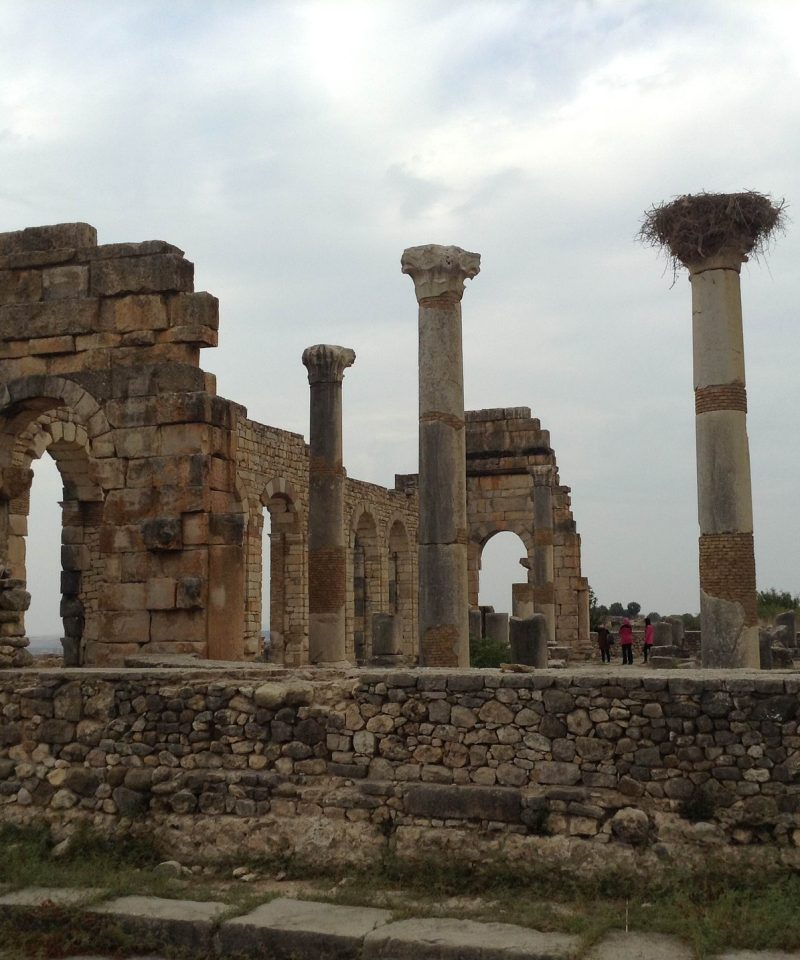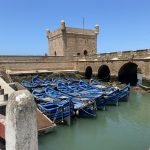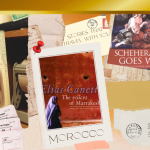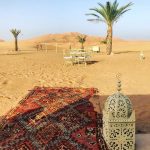Etymology
Meknes is named after a tribe which, was known as (native Berber name: Imeknasen) in the medieval North African documents.
History
Early history (8th–16th centuries)
, a major -era settlement in Morocco and one of its early urban centres, is located near the site of the current city of Meknes. The current city and its name, however, originate with a tribe called the who dominated this region and much of eastern Morocco as early as the 8th century. Some sources attribute the effective founding of a settlement here to a group of small Miknasa villages known as miknāsat al-zaytūn in the 10th century. The founded a fortress or fortified settlement just south of these villages after conquering the area in 1061, originally called Tagrart or Taqrart. Some sources attribute the founding of the city of Meknes to this Almoravid foundation. The city’s first (the current ) is in turn believed to have been first built by the Almoravids in the 12th century. The , often reputed to be the oldest mosque in the city, also dates back to the Almoravid period.
The fortress resisted the military advance of the , who destroyed the city after a long siege in the 12th century. However, at the beginning of the 13th century the Almohad caliph (ruled 1199–1213) rebuilt the city and its fortifications, as well as its Grand Mosque. The city enjoyed relative prosperity in this period, before being conquered again by the new in 1244. The first (citadel or governor’s district) of Meknes was created afterwards by in 1276 CE – the same year that the citadel of was built in nearby , the new capital. During this period, Meknes was frequently the residence of Marinid princes (often appointed there as governors) and especially of . The Mosque of the Kasbah (the later ) was also founded and first built in 1276. The Marinids also carried out major restorations to the Grand Mosque in the 14th century and built the major madrasas of the city near it. The latter included the (built in 1336) and two other madrasas, Madrasa al-Qadi and Madrasa Shuhud, all built by Sultan .
After the end of the Marinid and periods, however, Meknes suffered from neglect as the new dynasty (16th and early 17th century) focused their attention on their capital at and neglected the old northern cities of Morocco.
The reign of Moulay Isma’il (17th–18th centuries)
It wasn’t until the dynasty in the second half of the 17th century that Meknes received renewed attention. Under (ruled 1666–1672), the first Alaouite sultan to unite Morocco under his rule, Fes became the capital once more and his brother, , governed Meknes. Upon Rashid’s death in 1672, Moulay Isma’il became sultan and chose Meknes as his new capital. In addition to his possible attachment to the city as a governor, a number of reasons may have favoured this choice. One may have been the fact that Ismail had to fight hard to reconquer both Fes and from his rival nephew (Ahmad al-Mahriz, son of Moulay Rashid) during the first years of his reign, which may have rendered him skeptical towards both cities as possible centers of power. Moreover, Moulay Rashid had garrisoned much of Fes with his own contingents from the and eastern Morocco while Moulay Isma’il was forming his own personal royal guard composed of slaves (‘abid) from , and there may have been concerns that not all these contingents could be garrisoned simultaneously in Fes. The (religious scholars) of Fes were also particularly disapproving of his ways, including his use of slaves (many of whom were of Muslim background), and maintained tense relations with him throughout his reign. Choosing Meknes thus removed him from the influence of traditional elites and allowed him to build a fresh base from which he hoped to exercise absolute power. The threat of attacks from the east (from ) and the increasing insecurity in central Morocco due to tribal migrations from the and regions may have also persuaded Ismail that Meknes, situated further west, was more defensible than Fes.
Whatever the reasons, Ismail made Meknes the center of Morocco in his time and he embarked on the construction of a new on the south side of the old city. Its construction continued throughout the 55 years of his reign, beginning immediately after his accession to the throne in 1672. Existing structures dating from the earlier medieval kasbah of the city were demolished to make way; the name of the large public square in front of the Kasbah today, el-Hedim (or Place el-Hedim), means “the rubble” and came from the masses of rubble and debris which were piled here during the demolition. Labour was carried out by paid workers as well as by contingents of slaves, particularly . Estimates on the total number of workers involved range from 25,000 and 55,000. Nonetheless, frequently-told stories about the tens of thousands of Christian slaves used for labour and the large underground dungeons where they were kept are somewhat exaggerated and originate from the accounts of European ambassadors who visited Isma’il’s court (often to negotiate the release of prisoners from their countries). In reality, the number of Christian slaves was likely closer to a few thousand at most and the chambers popularly called “prisons” were actually storage rooms for grain and supplies.
It was also in Moulay Ismail’s reign that the Jewish inhabitants of the city were moved to a new or Jewish district to the west, near the Kasbah, not unlike the or that of Marrakesh. The Mellah was located between the old medina, west of Place el-Hedim, and the more outlying quarter of Madinat al-Riyad al-Anbari. Both the Mellah and Madinat ar-Riyad were part of an urban extension ordered by Isma’il in the western angle between the old city and the Kasbah. Moulay Isma’il also undertook works throughout the old city too. He refortified the walls and built new monumental city gates such as Bab Berda’in and . He also built several other or garrison forts throughout the city to house his ‘abid troops and help protect (and control) the rest of the town, such as the Kasbah Hadrash and the Kasbah Tizimi. He carried out renovations to the Grand Mosque and the nearby Madrasa al-Qadi (which he devotes to students from the ), and founded the Zitouna Mosque. , one of his wives who was (minister) under him (and briefly became ruler of Morocco in 1728 after his death), was responsible for founding the , completed in 1709.
One of the last constructions before his death, carried out between 1721 and 1725, was the Heri al-Mansur, a palace on the far southern edge of the kasbah which included vast stables. The monumental gate known as Bab al-Mansur al-‘Alj, overlooking Place al-Hedim, was only finished in 1732 by his son . His son and brief successor, , carried out modifications to his during his two brief reigns (in 1727–28 and 1728–29) and was himself buried here in 1729.
Later Alaouite period (18th–20th centuries)
Following Moulay Isma’il’s death, however, the political situation in Morocco degenerated into relative anarchy as his sons competed for power. Meknes lost its status as capital and suffered damage in the . The city was neglected and many parts of the enormous imperial kasbah fell into disrepair. The site received only occasional royal attention in the following centuries. Sultan , who ruled between 1757 and 1790, built a number of projects in the city. He added the Dar al-Bayda Palace in the Agdal garden to the southeast of the main palace complex, which was later turned into a . He constructed the in the southern part of Moulay Isma’il’s Kasbah, which became the largest mosque in Meknes. He also renovated and added a over the tomb of Sidi Mohammed ben Aissa (just outside the city walls) and built the current minarets of the Grand Mosque and the Nejjarine Mosque in the old city. The Dar al-Kebira, however, was abandoned and progressively transformed into a residential neighbourhood where the inhabitants constructed their houses within and between the former palace structures of Isma’il’s time. In the early 19th century, Sultan added a loggia structure in front of Bab al-Mansur which served as a meeting place for ceremonies and the governor’s tribunal, though this structure was later removed.
Recent history (20th–21st centuries)
After the installation of in Morocco in 1912, the French administration created a new city () on a nearby plateau across the valley on the northeast side of the old city. The capital of Morocco was moved from Fes to , further marginalizing cities like Meknes (which is near Fes). Some traditional Muslim authorities and officials were retained, but Meknes was reorganized under a new French municipal and military regime. This also leads to a greater influence of the cities over their surrounding countryside and growing urbanization. The city became a transportation hub for people and goods traveling from east to west or from north to south across the country, in addition to hosting extensive military barracks. The population of Meknes grew from 25,000 at the beginning of the century to over 140,000 by the mid-20th century. Some roads in the old city were widened to accommodate greater circulation, but most of the new development took place in the Ville Nouvelle. The new French authorities took interest in the conservation of historic monuments in the old city; the madrasas, for example, were restored in 1922. During this period Meknes also became a center of agriculture and , led mainly by French colonists who appropriated large amounts of land nearby.
Nonetheless, Meknes, like other cities, also hosted resistance to French authority. In 1937, a particularly serious and violent revolt erupts following attempts to divert the local river to benefit the French settler population during a time of food shortages for the native Moroccan population. A violent suppression of protests takes place in the city which results in 13 dead and more injured. Following Morocco’s independence in 1956, the changes which began or accelerated under French rule still continue to run their course. Large scale rural migration increases the population of the city and intensifies the urbanization process (as elsewhere in the country). Industries develop around the city’s perimeter, but at the same time the old elites and families move away to the coastal cities like and Rabat.
These changes have also contributed to the relative neglect of the old city. According to the Heritage at Risk report of 2000, the historic city of Meknes contains insufficient drainage systems, and as a result, suffers from inundation and leakage in certain areas. Still, some conservation and restoration efforts have taken place in recent years, motivated in part by the revenues of tourism.
Geography
Meknes is located in a strategic position in the heart of . To its south and south-east are the rich cedar forests and mountains of the mountains with the cities and ; and more to the south are the rich oases of . To the west are the two largest metropolitan areas of Morocco: and . To the north is the mountainous north of with the cities of and . and lie east of Meknes.
Historic monuments and landmarks
The main historic monuments of the city are concentrated in the (old city) and the vast former to the south. The most notable monuments are listed below.
Place el-Hedim
Often compared to the square in , el-Hedim Square (Place el-Hedim) is a vast plaza at the southern end of the old city, before the main gates of Moulay Isma’il’s former royal palace complex. The square’s name, el-Hedim, means “the rubble/debris” and refers to the demolitions which Moulay Isma’il carried out here during the construction of his palaces. He left this open space as a public square to separate his palace from the rest of the city. Since then, the square has become the focus of various activities including evening entertainers such as storytellers, acrobats, and musicians.
Mosques and madrasas
: The old city’s most important mosque and one of its oldest, covering about 3,500 square meters and was founded in the 12th century by the , although renovated multiple times since.
: The city’s most famous (school for higher learning in Islamic sciences) was established by the sultan in 1335-36 but is now named after his son (who may have later restored it). Open to tourists today, it is one of the most richly decorated buildings in the city.
Nejjarine Mosque: Often reputed to be the oldest in the city, this mosque also dates back to the Almoravid period, though it has been modified multiple times.
: The main mosque of the city’s former kasbah and of , it was first founded in the Marinid era but completely rebuilt by between 1672 and 1678. Its prominent minaret is visible from the adjoining Place Lalla Aouda (Lalla Awda Square).
: The mosque, located near the northern gate of the medina (Bab Berda’in) was completed in 1709 on the orders of Morocco’s first female minister, . The mosque was the site of a tragedy in 2010 when its historic collapsed, killing 41 people. The mosque has since been repaired and its minaret rebuilt.
Ar-Roua Mosque: The largest mosque in Meknes, it was built by Sultan between 1757 and 1790. It is located near the Heri al-Mansur palace in the southern part of the Kasbah of Moulay Isma’il.
Zitouna Mosque: A large mosque founded by Sultan Moulay Isma’il around 1687.
: Also known as the Mausoleum of Sheikh al-Kamel. An important mausoleum and religious complex () just outside the city walls to the northwest, originally dating from the late 18th century but restored later. , founder of the , a major brotherhood in Morocco, is buried here. He is considered the patron saint of Meknes, and his annual moussem (festival) is one of the most intense and was historically known for its displays of self-mutilation.
Zawiya of Sidi Kaddour el-Alami: A richly-decorated mosque and religious complex honoring the tomb of , a famous Moroccan poet who died in 1850.
Fortifications and gates
: The most famous gateway of the city (also known as Bab Mansour or Bab el-Mansur), this gate overlooks the southern end of Place el-Hedim and acted as the ceremonial grand entrance to the . It was begun in the later years of Moulay Isma’il’s reign and finished in 1732 by his son . Its name comes from the architect and designer of the gate, Mansour al-‘Alj (the “Victorious Apostate”), a former Christian slave who converted to Islam. It is notable for its size and its rich decoration consisting of motifs carved into brick, filled with colourful ( ), and topped by a long and elaborate painted on tile.
Bab Jama’ an-Nouar: Another ornate gate located next to Bab Mansur; also called Bab al-Nuwwar in some sources.
Bab ad-Dar al-Kebira: The monumental gate entrance to the Dar al-Kebira palace, dating to 1679–80.
: A monumental western gate of the city, near the former , dating from 1687 under the reign of Moulay Ismail and richly decorated with motifs and zellij similar to Bab al-Mansur.
: The monumental northern gate of the city, also built by Moulay Isma’il and richly decorated.
: A tower built in the 17th century as a part of the defensive walls of the in Meknes, . Since 2003 it holds a museum.
Imperial Palaces of Moulay Isma’il
The palace complex or “imperial city” of Sultan Moulay Isma’il was constructed over his entire 55-year reign from 1672 to 1727 (with some elements finished or remodeled shortly after). It occupies the site of the city’s former medieval (citadel) and stretches over an area approximately four times larger than the old city itself. It was composed of several autonomous palaces along with vast gardens, religious buildings, and other amenities. The complex was also notable for its impressive infrastructure, which included a water supply system with a hydraulic system of wells, norias (water extraction mechanism powered by wheel), canals, and underground pipes which distributed water to the royal city’s many buildings. It also contained numerous monumental granaries and underground warehouses which stockpiled supplies that could allegedly sustain the city for a siege of ten years. Below is a list of some of its main areas and monuments.
Place Lalla Aouda: A vast open square which stands behind (southeast of) Bab al-Mansur, which served as the former of the palace. It precedes the former Dar al-Kebira palace and gives access to the .
Dar el-Kebira: The oldest palace in the kasbah, finished in 1679 and itself composed of multiple palaces. Its name means “the Great House”. It was the private residence of the sultan and his family, connected directly to the Lalla Aouda Mosque and the later royal mausoleum. The palace fell into ruin after Moulay Isma’il’s death (and after the 1755 Lisbon Earthquake), and has since become a residential neighbourhood where common people built their houses amidst the remains of Isma’il’s massive palace walls, still visible in various places.
: The royal mausoleum and funerary complex of Moulay Isma’il and some of his family members and successors. It was built under his reign but significantly modified by between 1727 and 1729. The funerary complex was originally entered from the dar al-Kebira to the north but is nowadays entered by a 20th-century gate to the south. Still considered a religious site today, it is also open to tourists. It is composed of relatively austere courtyards leading to a richly-decorated indoor chamber, which in turn grants access to the tomb chamber of the sultan.
Qubbat al-Khayyatin and the Qara Prison: The Qubbat al-Khayyatin is a standalone audience chamber or throne room where Moulay Isma’il once received foreign ambassadors. Underground, right next to it, is a large subterranean vaulted space known as the or Habs Qara. Although frequently described as a prison for Christian slaves, scholars agree that it was in fact a storage area and granary, one of many such structures throughout the royal city.
Dar al-Makhzen: This vast walled enclosure, much larger and more rationally organized than the Dar el-Kebira, contained extensive gardens and two more main palaces in Moulay Isma’il’s time, some of which have been restored or adapted for current use as one of the royal residences of the . The enclosure, generally known as the Dar al-Makhzen (not to be confused with the and elsewhere), was divided into two sections. The western section was mostly occupied by the Bahrawiya Gardens but also contained a long narrow palace on its northern edge known as the Dar al-Madrasa (“House of the School”), most likely another private palace of the sultan. The eastern section, which is still entered via an ornate royal gate on its eastern perimeter (north of Heri es-Swani), was mostly occupied by the Qasr al-Muhannasha (“Palace of the Labyrinth”). This palace consisted of roughly eight large courtyards or garden enclosures and acted as both a reception palace and an administrative palace.
: The Sahrij or Agdal Basin is an enormous water basin or artificial lake south of the Dar al-Makhzen, which was originally a part of the royal city’s water supply system. It measures 148.75 by 319 meters and is, on average, 1.2 meters deep. Next to it, on its eastern side, is an enormous structure composed of two parts: the “House of the Ten Norias” or Dar al-Ma (“House of Water”) and the Heri as-Swani (also spelled as Heri es-Souani). The first of these is a monumental building of vaulted passages and domed chambers which contained a number of wheel-powered hydraulic mechanisms () which drew water from the underground to the surface, after which it was delivered into the Sahrij or redistributed to the city. The second part, the Heri as-Swani, is attached to the south side of this building and is made up of 22 rows of monumental arches which once held up a roof (which has since collapsed). Although frequently misidentified as the “royal stables” of the palace, this structure was, once again, a massive granary and storehouse. Grain was originally delivered to the building by mules who climbed onto a roof terrace and dropped the grain directly into holes pierced above each vaulted chamber.
Heri al-Mansur: One of the last constructions of Moulay Isma’il’s reign, built between 1721 and 1725, its name means “Granary/silo of Victory”, but it was also known as Dar al-Mansur or Qasr al-Mansur (“Palace of Victory”). It is located on the far southern perimeter of the Kasbah and consists of a massive building which seems to have served as a palace, fortress, and storehouse. The basement was taken up by storage rooms while the upper floor held reception rooms for the palace with views over the surrounding area. Located next to it were the Royal Stables of Moulay Isma’il (often misidentified today with the Heri as-Swani), which were reputed to be one of the palace city’s most impressive features. It consisted of horse stalls sheltered under two parallel arcades (rows of arches) which stretched for 1200 meters on either side of a water canal which provided water for the horses. Unfortunately, the stables have not been preserved and very little remains of them today.
Museums
: The best-known museum in Meknes, housing a number of artifacts and art objects from the city and other regions in Morocco. It is housed in a late 19th-century palace with gardens and ornate rooms built in 1882 by Mokhtar ben Larbi Jamai, who served as under Sultan (ruled 1873–1894). His family also built the in Fes.
Musée de Meknès (Meknes Museum): A small museum housed in a structure just northeast of Bab al-Mansur, exhibiting artifacts from all over Morocco.
Outlying sites
The ruins of the town of (Oualili), another , are about half an hour to the north, as is the village and important pilgrimage site of .






